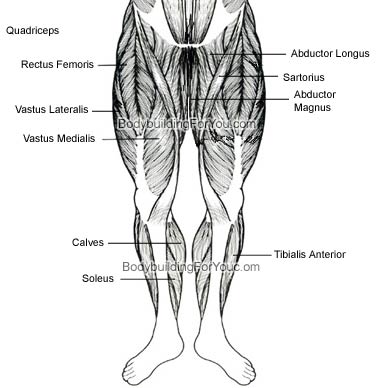Leg Muscle and Leg Muscle Anatomy
Quadriceps Muscle
More commonly referred to as the ‘quads,’ no workout is complete without at least some time spent on these large leg muscles. The quadriceps are the muscles at the front of the thigh, which act as the extensors of the leg. The muscles involved include the rectus femoris, vastus intermedius, vastus medialis (inner thigh), and vastus lateralis (outer thigh).
The basic function of the quadriceps muscle is to extend and straighten the leg. The upper thigh muscles are the largest and most powerful muscles in the human body. With all things considered, your leg mass make up about 50% of your body mass - you just cannot afford to avoid leg training.
Vastus lateralis
The Vastus lateralis is the largest muscle of the Quadriceps. From wikipedia:
The Vastus lateralis (Vastus externus) is the largest part of the Quadriceps femoris. It arises by a broad aponeurosis, which is attached to the upper part of the intertrochanteric line, to the anterior and inferior borders of the greater trochanter, to the lateral lip of the gluteal tuberosity, and to the upper half of the lateral lip of the linea aspera; this aponeurosis covers the upper three-fourths of the muscle, and from its deep surface many fibers take origin.
The main function of vastus lateralis is to extend your knee from the bent position.
Leg Muscle Diagram

Vastus medialis
The vastus medialis originates from the lower intertrochanteric line, spiral line, and inserts into the medial quadriceps tendon and directly into medial patella. Its main function is to extend the leg the last 10%.
Rectus femoris
The rectus femoris is also one of the four quadriceps. It's located in the middle of the front thigh. It arises from the anterior inferior iliac spine, and inserts into the base of patella to form the central portion of the quadriceps. Its main function is also to straighten the leg.
Hamstring Muscle
The hamstring muscle refers to the three muscles located on the back of the upper thigh, and they are:
- Semimembranosus
- Semitendinosus
- Biceps femoris
Leg Muscle Diagram

Biceps femoris
The biceps femoris is a muscle of the posterior thigh composed of a long head and a short head. The long head arises from a common tendon with semitendinosus from the superior medial quadrant of the posterior portion of the ischial tuberosity. The short head originates from the lateral lip of linea aspera and lateral intermuscular septum of the thigh.
 The main function of the biceps femoris is to flex the knee and also rotate the tibia laterally. The biceps femoris also curls the leg back.
The main function of the biceps femoris is to flex the knee and also rotate the tibia laterally. The biceps femoris also curls the leg back.
Gluteus Maximus Muscle (The Glutes)
Also known as the glutes, the butt, or the behind, the gluteus maximus is the largest muscle in the body. The gluteus maximus is a large, thick muscle in a quadrilateral shape. The glutes acts as a major extensor of the hip joint. It extends the thigh at the hip, and assists in laterally rotating the thigh.
Gluteus Medius and Gluteus Minimus
There are three sections to the glute area: gluteus maximus, gluteus medius and the gluteus minimus. The gluteus minimus is the smallest of the three, and is located just beneath the gluteus maximus.
The gluteus medius is a broad, thick muscle located on the outer area of the pelvis. These muscles are responsible for abduction of the leg as well as rotation in both the internal and external way.
>> Click here for Total Gym - As Seen on TV with Chuck Norris & Christie Brinkley. 10% OFF with Promo Code: 11001
>> Click here for the BowFlex Home Gym




